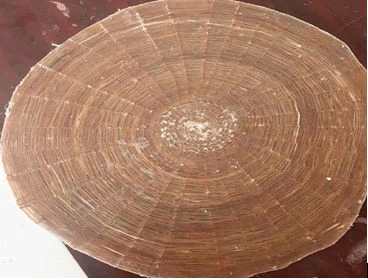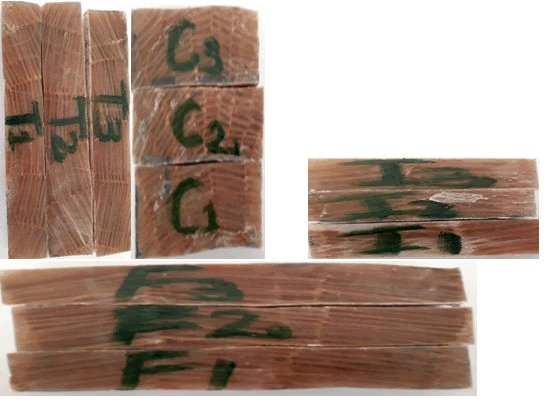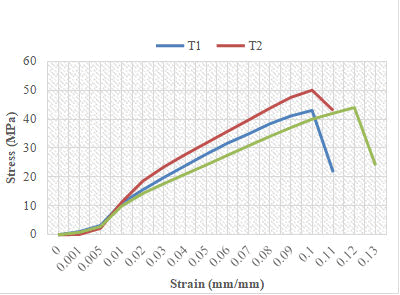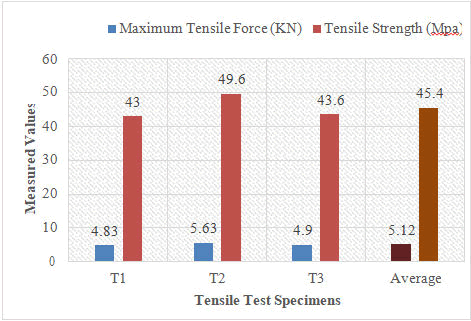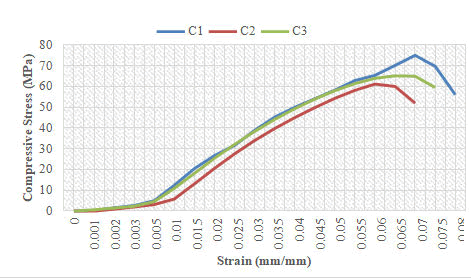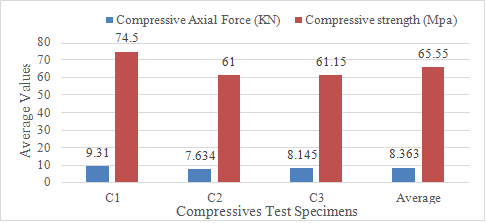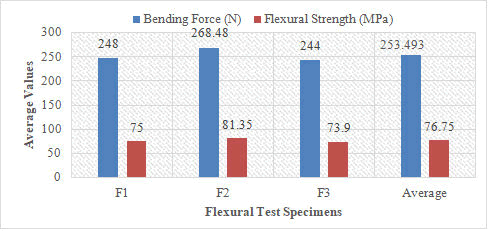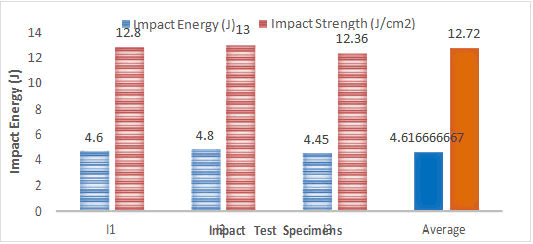Research Article, J Fashion Technol Textil Vol: 11 Issue: 5
Experimental Investigations on Bio-Inspired Sisal Fiber Reinforced Epoxy Composite for Foot Prosthetic Application
Temesgen Tilahun* and Samuel Tesfaye
Department of Mechanical Engineering, Addis Ababa University, Addis Ababa, Ethiopia
*Corresponding Author: Temesgen Tilahun
Department of Mechanical
Engineering, Addis Ababa University,Addis Ababa,Ethiopia;
E-mail: temtti5@gmail.com
Received date: 03-Apr-2023, Manuscript No. JFTTE-23-93895;
Editor assigned date: 06-Apr-2023, PreQC No. JFTTE-23-93895 (PQ);
Reviewed date: 20-Apr-2023, QC No. JFTTE-23-93895;
Revised date: 27-Apr-2023, Manuscript No. JFTTE-23-93895 (R);
Published date: 25-May-2023, DOI: 10. 4172/2329-9568.1000293
Citation:Tilahun T, Tesfaye S (2023) Experimental Investigations on Bio-Inspired Sisal Fiber Reinforced Epoxy Composite for Foot Prosthetic Application. J Fashion Technol Textil 11:2.
Abstract
The prosthetic foot is a device used as a replacement for amputees in the place of the biological part to have safe locomotion The major concern of this work is to investigate tensile strength, flexural strength, impact strength, compressive strength, and water absorption of spider web pattern sisal fiber reinforced epoxy composite. The prosthetics industry uses High-density Polypropylene (HPP) and composite material (carbon or glass) or hybrid fiber-reinforced epoxy composites. The high cost of fibers and low-strength PP are the problems of current prosthetic production. This research targets to model a lower limb prosthetic foot with better mechanical properties and affordable natural fiber (sisal) reinforced composite based on bio-inspired fiber orientation techniques. Hand layup manufacturing techniques were used to prepare a composite of 70% of epoxy matrix and 30% of sisal fiber (50 mm long fibers) knitted in spider web orientations. The fiber was treated with 5% NaOH for five hours and dried in an oven for two hours. Then five layered composites stacked together in the sequence of (0/3/6/9/12) degrees was prepared. The experimental results indicate that a spider web-oriented sisal fiber-reinforced epoxy composite has superior properties with a tensile strength of 45.6 MPa, a tensile modulus of 1.2 GPa, a flexural strength of 76.78 MPa, a flexural modulus of 3.42 GPa, the compression strength of 65.55 Mpa and compressive modulus of 2.229 MPa, impact strength of 12.72 J/cm2 with impact Energy resistance of 4.6 J and an average water absorption capacity of 3%. Hence the spider web-oriented sisal fiber-reinforced epoxy composite can be used as an alternative material for prosthetic foot manufacturers as suggested.
Keywords: Spider web, Tensile test, Flexural test, Impact test, Prosthetic foot
Introduction
A prosthetic foot is an externally applied device for lower limb amputees and studies indicate approximately 38 million people worldwide are living with major amputations without prostheses. Out of this, over 85% are lower limb amputations. Those lower limb amputation devices are designed to restore basic mobility [1]. The prosthetic foot device systems include shock absorbing systems, torsion adapters, and an innovative attempt at foot design that minimizes gait defects These effects allow patients to regain mobility and provide independence to perform activities of daily living.
The material development for prosthetic foot application opens wide room for researchers. This is because customizing composite materials for replacing the conventional materials for prosthetic foot application helps to gain desired properties. Polymer composite materials provide higher elastic modulus properties and can be fabricated targeted to their application area.
Manufacturing prosthetics foot in Ethiopia started in very recent years. It is manufactured from polypropylene material in the Ethiopian POC center [2]. In addition to this prosthesis and orthosis devices are also manufactured from carbon and glass fiber materials with epoxy matrix.
Many researchers worked on synthetic fiber-reinforced polymer composites for prosthetic foot applications. But synthetic fibers reinforced polymer composite for prosthetic applications are not always suitable although good mechanical properties. Hence the present study focused on bio-inspired spider web-oriented sisal/epoxy polymer composite for prosthetic foot application. Besides this, this research work focuses on the development of bio-inspired material for biological element replacement applications with the characterization of mechanical properties [3-6]. This is due to the good properties of sisal natural fiber, less health impact, and suitability to prepare the selected orientation type holding the desired mechanical properties.
Materials and Methods
Hand lay-up technique
The sisal fiber was treated with a 5% NaOH solution to bring fiber surface modification to ensure increased water resistance and fibermatrix adhesion hence improved mechanical properties. The literatures disclose that the Sisal fiber alkaline treatment with 5% NaOH solution improves the properties up to 16%. Carefully studying the spider webs pattern, we have found an average of 30 radials which are layered in 12 degrees from each other. Taking the radials as the building block of the spider web pattern, we can only have 12 degrees span or (0,3,6,9,12) stacking sequence for composite layers with the 30% sisal fiber and 70% epoxy resin mixing ratio. Then the sisal fibermade spider web-oriented plies were prepared manually with 120 radial spacing with five stacking sequences. A circular 70 cm diameter smooth plate was prepared as an open mold to manufacture the composite with the hand lay-up technique. The surface of the mold was cleaned and lubricated with mold release wax as a thin layer to eliminate the bonding of the composite and mold surface for easy removal. The matrix was prepared from epoxy system 2000 mixed with system 2060 hardener at a 10:1 ratio with continuous stirring for some minutes to mix thoroughly.
After preparing all necessary materials the matrix was applied to the mold surface followed by the fiber stacking. During this, a roller brush was utilized to remove excess matrix and voids due to air bubbles. Finally, the composite was covered with a smooth plate and loaded with a load of 200 kg, and left for 24 hours to cure at room temperature. Finally, the cured spider web 002D oriented sisalepoxy polymer composite was detached from the mold and cut into test specimens (Figure 1).
Testing mechanical properties
The composite material fabricated from sisal-epoxy was cut to ASTM mechanical test standards to characterize the properties. Specimens were prepared for a tensile test (ASTM D638), flexural test (ASTM D790), compressive test (ASTM D3410), impact test (ASTM D256), and water absorption (ASTM D570) as shown in Figure 2 with their respective dimensions. For each test, three specimens were prepared and tested. The average results of the specimens for each test were calculated and used for the result analysis.
The tensile, compressive, and flexural tests were conducted on com puter controlled electromechanical universal testing machine while the impact test was with computer controlled charpy impact test machine at Addis Ababa science and technology university. The tests on the universal testing machine were managed at 2 mm/min speed and recorded all data until the specimen failed. All tests are conducted under the ambient temperature including water absorption [7-9]. In water absorption, the dry weight of the specimens was measured and then soaked in tap water for one day. After one day the wet weight of the specimens was measured and the percentage of weight change was taken as the water absorption rate.
Results and Discussion
Tensile properties
The result of the experimental tensile test for three specimens of the spider web-oriented sisal-epoxy polymer composite is recorded with their average value. The tensile test of the spider web-oriented sisal/ epoxy polymer composite and the stress-strain relationship generated from the universal testing machine is shown in Figure 3 with an average maximum tensile strength of 45.4 MPa and modulus of 1.2 GPa at an average maximum force of 5.12 KN in Figure 4.
Compressive properties
After preparing the specimens according to the ASTM standard, the testing on the UTM with compressive fixture gave the following results in terms of stress-strain and maximum force that each specimen could carry in compressive [10-14]. The compressive test results of the spider web-oriented sisal/epoxy polymer composite of the stressstrain relationship generated from the universal testing machine are as shown in Figure 5 with average maximum compressive strength of 65.55 MPa and modulus of 2.229 GPA at an average maximum compressive force of 8.36 KN in Figure 6.
Flexural properties
The specimens prepared for the flexural strength test were arranged with a span length of 101 mm and an offset cantilever length of 12 mm. The testing machine gives the maximum bending force and the corresponding maximum flexural strength for the material under test. Specimen two in the flexural strength test resulted in a higher value of 268.48 N bending force under the three-point bending testing procedure [15,16]. Using the relations, the flexural strength becomes 76.8 MPa. The lower values are observed in specimen three. The results of each test and their average values are shown in Figure 7.
The specimens prepared for the Charpy impact test according to ASTM D256 were notched to create a stress concentration area that precisely indicates the point of failure. The computer controlled Charpy impact test machine displayed the amount of impact energy absorbed by each specimen under the same testing conditions in Figure 8 for three specimens.
Time taken for the encryption of data
Under the impact test, the specimens of the spider-oriented sisal/ epoxy polymer composite resulted in higher impact energy absorption of 4.62 J with an impact strength of 12.72 J/cm2. Specimen three gave the minimum energy absorption result under the testing condition. Finally, the average of the impact energy absorption capacity of the three specimens was calculated (Table 1).
| No | Mechanical properties | HPP | Current work |
|---|---|---|---|
| Experiment | |||
| 1 | Density | 0.905 g/cm3 | 1.28 g/cm3 |
| 2 | Tensile strength | 37.3 MPa | 45.4 MPA |
| 3 | Tensile modulus | 1.4 GPa | 1.2 GPA |
| 4 | Compressive strength | - | 65.6 MPa |
| 5 | Flexural strength | 48.3 MPa | 76.8 MPa |
| 6 | Flexural modulus | 1.344 GPa | 3.42 GPa |
| 7 | Impact strength | - | 12.72 J/cm2 |
Table 1: Property comparison of HPP and sisal epoxy composite.
Conclusion
In this research work properties of sisal epoxy composite with bio mimic spider web pattern reinforcement orientation have been investigated and analyzed. A tensile test, compression test, flexural test, impact test, and water absorption test were conducted.
The conclusions of this work are summarized as follows:
• Transforming the bidirectional fiber orientation material properties successfully helps the estimation of radial and circumferential properties with less than 20% error in experimental results.
• The impact strength of the spider web pattern sisal fiber reinforced epoxy composite decreases from the center of circular ply to the outer side.
• A new composite spider web pattern sisal fiber reinforced epoxy composite can
• carry load from any direction due to radial and circumferential patterns of fiber.
• The average impact strength investigated in the experimental analysis is better than previous literature investigations with an amount of 12.72 J/cm.
• The average water absorption of the three tested specimens is 3.0% which is in the acceptable range in comparison with the literature findings.
• Analyzing the geometry of spider web orientation of radials and spirals the better stacking sequence of (0,3,6,9,12) ply orientations yields better mechanical properties with the material composition of 30% sisal and 70% epoxy matrix.
• The prosthetic foot designed from HPP has 37 MPa ultimate tensile strength limits whereas the spider web fiber-oriented composite has 46.5 MPa which indicates a 12.5% improvement.
• Better flexural strength was achieved with spider web-oriented sisal epoxy composite with an amount of 76.8 Mpa which can be selected over the mostly used prosthetic material HPP with a flexural strength of 48.3 Mpa.
• The composite prosthetic material developed in this research has an impact strength of 12.72 J/cm and compressive strength of 65.55 Mpa.
Declaration of Competing Interest
The authors declare that they have no known competing financial interests or personal relationships that could have appeared to influence the reported work in this paper.
References
- Prost V, Johnson WB, Kent JA, Major MJ, Winter AG (2022) Biomechanical evaluation over level ground walking of user-specific prosthetic feet designed using the lower leg trajectory error framework. Sci Rep 12: 5306.
[Crossref] [Google Scholar] [PubMed]
- Tryggvason H, Starker F, Lecompte C, Jonsdottir F(2017) Modeling and simulation in the design process of a prosthetic foot. InProceedings of the 58th Conference on Simulation and Modelling (SIMS 58) Reykjavik, Linkoping University Electronic Press, Iceland, pp. 398-405.
- Frossard L, Laux S, Geada M, Heym PP, Lechler K (2022) Loading characteristics data applied on osseointegrated implant by transfemoral bone-anchored prostheses fitted with state-of-the-art components during daily activities. Data Br 41: 107936.
[Crossref] [Google Scholar] [PubMed]
- Baharuddin MH, Ab Rashid AM, Nasution AK, Gan HS, Ramlee MH (2021) Patient-specific design of passive prosthetic leg for transtibial amputee: Analysis between two different designs. Malaysian J Med Health Sci 17: 228-234.
- Saad H, Abdullah MQ, Wasmi HR (2017) The Modeling and Effect of FEM on Prosthetic limb. Int J Curr Eng Technol 7: 892-895.
- South BJ, Fey NP, Bosker G, Neptune RR (2010) Manufacture of energy storage and return prosthetic feet using selective laser sintering. J Biomech Eng 132: 015001.
[Crossref] [Google Scholar] [PubMed]
- Childers WL, Takahashi KZ (2018) Increasing prosthetic foot energy return affects whole-body mechanics during walking on level ground and slopes. Sci Rep 8: 5354.
[Crossref] [Google Scholar] [PubMed]
- Silva Júnior WC, Oliveira MA, Bonvent JJ (2015) Conception, design and development of a low-cost intelligent prosthesis for one-sided transfemoral amputees. Res Biomed Eng 31: 62-69.
- Ismail R, Paras Utami D, Arid Irfai M, Jamari J, Bayuseno AP (2021) Mechanical properties of carbon-matrix composites for a blade runner’s artificial leg. Cogent Eng 8: 1923382.
- Oleiwi JK, Hadi AN (2021)Properties of materials and models of prosthetic feet: A review. Mater Sci Eng 1094: 012151.
- Shahar FS, Sultan MT, Lee SH, Jawaid M, Shah AU, et al. (2019) A review on the orthotics and prosthetics and the potential of kenaf composites as alternative materials for ankle-foot orthosis. J Mech Behave Biomed Mater 99: 169-185.
[Crossref] [Google Scholar] [PubMed]
- Bekele AE, Lemu HG, Jiru MG (2022) Experimental study of physical, chemical and mechanical properties of enset and sisal fibers. Polym Test 106: 107453.
- Prasad GE, Gowda BK, Velmurugan R (2017) Comparative study of impact strength characteristics of treated and untreated sisal polyester composites. Procedia Eng 173: 778-785.
- Rajak DK, Pagar DD, Menezes PL, Linul E (2019) Fiber-reinforced polymer composites: Manufacturing, properties, and applications. Polymers 11: 1667.
[Crossref] [Google Scholar] [PubMed]
- Betelie AA, Sinclair AN, Kortschot M, Li Y, Redda DT (2019) Mechanical properties of sisal-epoxy composites as functions of fiber-to-epoxy ratio. AIMS Mater Sci 6: 985-996.
- Vidakis N, Vairis A, Petousis M, Savvakis K, Kechagias J (2016) Fused deposition modelling parts tensile strength characterisation. Acad J Manuf Eng 14.
 Spanish
Spanish  Chinese
Chinese  Russian
Russian  German
German  French
French  Japanese
Japanese  Portuguese
Portuguese  Hindi
Hindi 